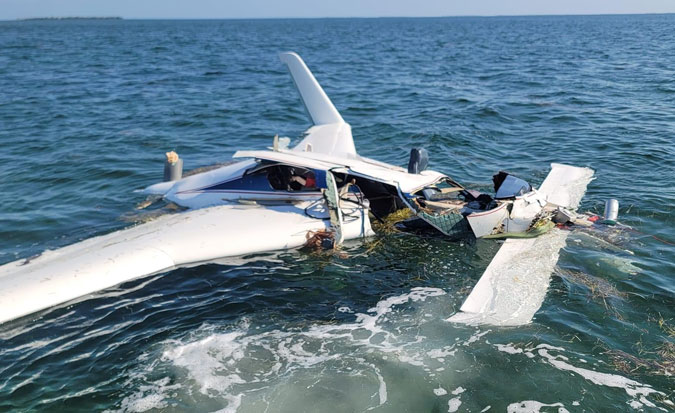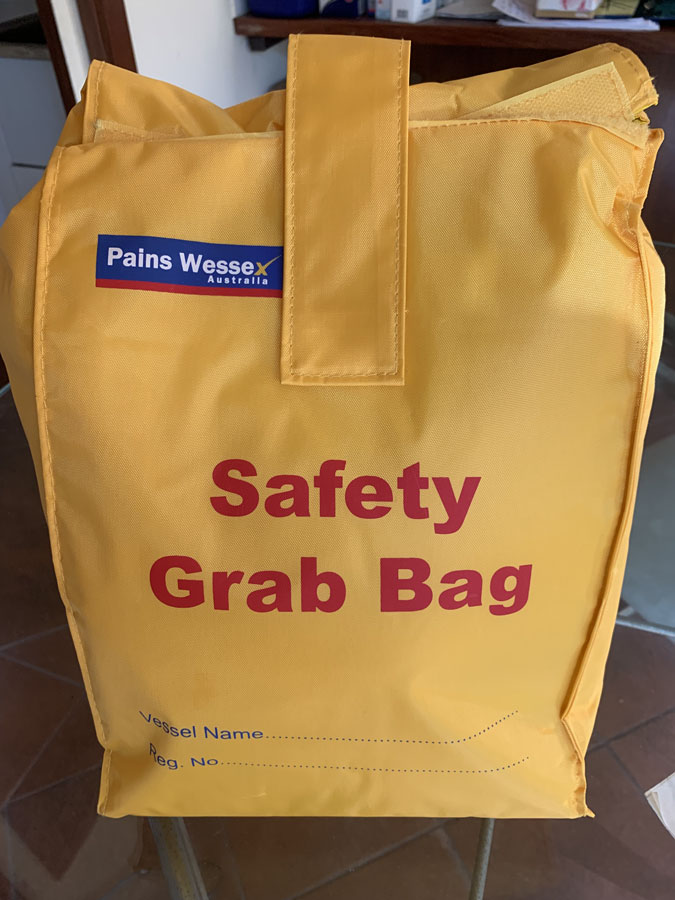Survival Kit – Take it so you won’t need it

Well, maybe I will need it. Crossing large areas of ocean mean I must be prepared for a ditching and understand what might happen. A forced landing, on land, still needs a lot of thought into what might be required to survive. In both cases I may not be rescued for a while or have injuries I’ll have to deal with on my own.
In a Long-EZ (or Velocity as above) we float. Assuming the pilot survives the ditching, it looks like staying in the cockpit is not an option. At least the plane isn’t going to sink so I’ll have more time to get my raft, inflate it and tether it to the wreck. Of course I’ll want to get my ‘Grab bag’ too. What is in the bag follows:-
This list is gathered from the wisdom of others and one instructor in particular. It will be constantly refined and adapted for my solo efforts and for my particular mission. I’ll leave the unedited version at the bottom of this page. What follows is MY kit.
CONTAINER
Boating ‘Safety Grab Bag’. They float, can be Velcro sealed and have a carry strap.
HARDWARE/CONTENTS
- First aid kit – (small black brick like bag in the photo)
Saline – Reclens 15ml ampoules x4 – clean wounds before dressing
Water purification tablets – Aquatabs
Acticoat Dressing – Silver Impregnated, burns anti infection (I think I lost this!)
Kaltostat dressing – stops bleeding
Dressing – Mepilex – large stick on
Dressing – Elasoplast Non-stick x2
Antiseptic Ointment Betadine 25g tube
Crepe bandages
Bandaids (assortment)
PrimaTape – all purpose, good on skin 1.25 x 5m
Sissors (blunt end nurses style)
Tweezers – Splinters, debis in wounds
Body Warmers – Hothands ‘stick on cloths’ heat pack
Sunscreen SPF50+
Pain Tablets – Mersynofen Ibuprofen 200mg,
Foil and Foil Blanket
Zyrtec – allergy, itchy skin
Imodium – if diarrhea to reduce dehydration
Motion Sickness – TravelCalm (guards against dehydration in a ditching)
Anti-itch cream Cortic-DS 1% cortisone
Insect repellent Aerogard rollon
- Cigarette lighter. Wrapped with some GAFFA tape.
- Waterproof matches
- A sharp folding knife – Flight Outfitters, incls Magnesium alloy Firestarter, LED, Belt Cutter, window breaker
- Thin Rubber gloves – no idea what for
- 30′ Type IV Parachord 340kg min
- 5m of clear vinyl tubing to obtain water for storage
- A small roll of Gaffa tape.
- Two Lumo Glow sticks 15 hours each, Red, white
- Mosquito head net.
- Signal mirror Coglans #9900
- Folding pruning saw Coglans
- ACR Firefly waterproof strobe light.
- Poncho Stash XTM reusable
- Thermal survival blanket. 210x140cm Lifesystems
- 2 x large clear plastic zip lock bags
- Survival bag Orange. Cochlan
- Poly string. 80m
OTHER
- Lifejacket Switlik Aviator (with light and whistle)
- LIFERAFT (Survitec Aerolite One or Switlik ISPLR) still to be acquired
- PLB (Personal Locator Beacon) – Ocean Signal rescueME PLB1 still to be acquired
- Satphone still to be acquired
- Garmin inReach Mini 2 still to be acquired
- Naturehike Backpacking Tent with groundsheet 1.5kg
- A sleeping bag and lightweight ground mattress still to be acquired
- A working torch will be in the plane (add spare batteries)
_________________________________________________________________________________________________
AIRCRAFT CROSS COUNTRY ‘AIRCRAFT DOWN’
SURVIVAL KIT
INTRODUCTION
In both the flying game and the survival game the person who plans ahead is the person who is least likely to have a problem. In the aviation game having a quality survival kit will ensure that in the unlikely event of a forced landing that kit will assist to ensure that the issues encountered will be at a minimum.
The kit below was put together by Dave XXXXX for his own use when doing serious cross country flying and domestic aircraft ferry work. The contents listing come from the study of forced landing accidents/events and the survival or not of the aircraft occupants. This kit is suitable for two persons.
CONTAINER
In this listing the various items are held in a Pains Wessex Boating ‘Safety Grab Bag’. Yellow in colour, these are available at any good chandlers or Whitworths Marine & Leisure mail order supply, (www.whitworths.com.au). They float, can be Velcro sealed and have a carry strap.
HARDWARE/CONTENTS
- First aid kit (almost brick sized). One needs to think about what injuries could come from a forced landing and crash and therefore what items to pack in the first aid kit. It is worth while date tagging the first aid kit and re-repacking and updating it every so often. In addition a Small first aid pouch is the thing to carry for small cuts and for panadol etc. Use this before opening ‘the brick’.
- A cigarette lighter. Wrap this with Speed or GAFFA tape. The tape burns and can be used in small strips as a fire starter.
- A spark stick in a cover. Strike this against metal or push the plunger in and out to create a spark onto an avgas soaked rag or a touch of Lipease on a cloth can be of use to start a flame.
- A sharp folding knife in a belt pouch. A larger fixed blade knife would be better.Garden gloves — to protect hands from splinters and or hot items.
- 20′ 30′ of pare cord. Good for tying things together or help making a shelter.
- 5m of clear vinyl tubing to obtain water for storage
- A small roll of (grey) Gaga cloth type tape also called 100 mph or speed_ tape. Useful for any number of things. Securing an oil hatch, sealing a window draught,make a broken arm sling, use as a band aid, ‘Gorilla’ -brand it thought to be the best. Do not leave home without it.
- Two Lumo light sticks Good for about 6 hours each.
- A red neck scarf. Protection from the sun
- Two Coleman brand foil space blankets. (53″ x 83.5″).
- Two mosquito head nets.
- A signal mirror and whistle. With the signal mirror raise your thumb in the direction of a searching aircraft. Reflec_ the sunshine on to your thumb and you will be flashing the mirror at the searching aircraft.
- A quality folding pruning saw for cutting light timber for firewood.
- A wrist compass-
- A non-liquid prismatic folding cover Compass.
- An ACR Firefly waterproof strobe light. Putting this against a foil background sheet will help illumination.
- Two Coleman (orange) ponchos. Rain shelter.
- A 1.52 x 2.44m foil lined survival blanket. Can be used to huddle in, waterproof. Can be used to keep an injured person warm; be used to make a tent, ground sheet or gear cover.
- A 2′ x 1.5′ dear plastic zip lock bag. Good for water storage.
- Two Coleman survival bags Orange. Sized 7′ x 3′ these are instant water proof steeping bags, ground sheets, distress mats; Useful to prevent hypothermia and retain body heat. Put the likes of a few garbage bags of leaves under the survival bags to act as insulators from the cold ground underneath.
- One Kathmandu emergency shelter in an open ended tube tent 1.83m x 2.5m length. Steep two people. C/w 7m para cord for use to raise the roof of the tube tent.
- Four clothes pegs. Used to seal off one end of the tube tent.
- A yachting type flare launcher. Available from good chandlers. Understand no license required. Caution. Not allowed on an airliner. Considered to be a fire arm.
- A can of survival items from Best Glide ASE. Ultimate Adventurer Survival Kit. It contains some 30 useful items (list on back of can) in the std. kit and 33 in the Advanced Version.
- A roll of poly string. 80m. Good for tying foliage together to make a shelter.
- A small bottle of iodine. Several drops in collected water can fix any bugs. Also good to apply to small cuts and wounds.
OTHER
An immediate survival kit or first defense can be made up of a cigarette lighter, sharp knife and ELT. My sharp knife is a folding blade with a serrated edge. It will cut through a jammed seat belt quick — they do happen. These are best carried on one’s person such that if you get out alive from a burning wreck or an aircraft that has ditched you take the ELT, lighter and sharp knife with you and they are not lost with the wreck.
Water is important but one can survive without it for a few days. Best to carry water in a pack of 6-12 plastic bottles If only one container is carried and it gets damaged in an accident the water is gone. Not so with several bottles.
Food you can do without for a week or more. Consider carrying several tins of pressed meat. One can a day for each person. Typical that pressed meat has both fibre and fat.
In a forced landing in a remote area the immediate considerations are: Shelter, get a Fire going (warmth, build morale, cook food, able to throw green foliage or engine oil onto it to create smoke such that an air/ground rescue party can see your location). Attend to any injuries. Activate the ELT. Minimum movement to save energy. Have a small drink of water. Be confident.
A working torch c/w spare batteries should be in every pilot’s flight bag. Carry a copy of the ERSA book. Useful for a fire starter or as toilet paper. Clothing. Even on a hot day take a jacket – it will get cold at night after a forced landing.
A smart pilot will dress with skin cover to limit bums in a crash fire. Long pants and long sleeved shirts all help. Head cover. A car) with a low brim to ward off rays from the sun or retain body heat at night. Footwear. Good enough to walk somewhere but only as a last resort. Avoid plastic clothing. Fire will melt it onto skin.
This survival bag list and extras is by no means full or complete. Flares, laser beacons, survival vests, chocolate bars, food, swiss army pocket knife, VHF & UHF portable radios (fully charged) etc. can also be added. The list is endless.
How much is too little or too much is the choice of the pilot and packer. A decision could depend on where one is flying, how many people are involved, time of the year, terrain being flown over, weather, and space and weight available. This gear bag and kit weight is 4 kg for W&B purposes.
In recent year there have been a small number of forced landings. Considerations are; injuries, to be several days on the ground, excess heat or hypothermia. A kit such as the above will give greater chance of survival. Bush walkers and FWD enthusiasts could all benefit from such a kit.
- Do check your survival bag at intervals and tag the bag with the last check/repack date.
- Do lodge a flight plan with a SAR time and notify ATC if a diversion is made.
- Remember the Scouts motto, ‘Be Prepared’ and to that I say ‘Be Prepared and it is unlikely to happen’.


